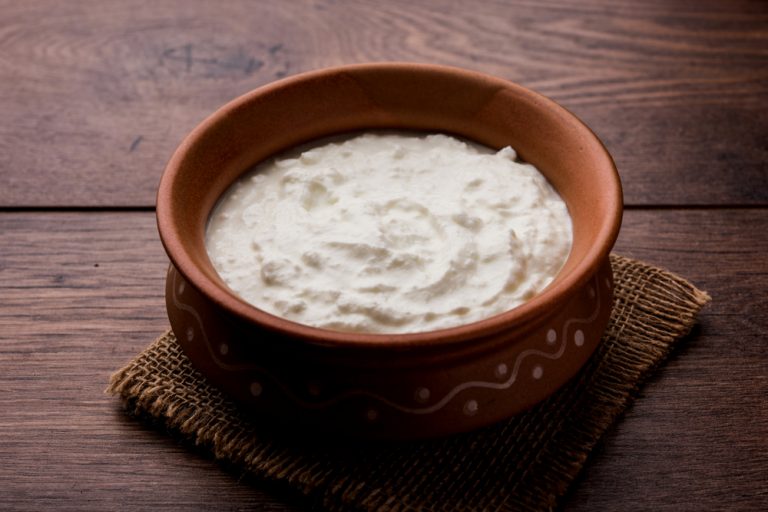White cheese (cottage cheese) can be tastiest when it is medium-pressed and smooth in cross-section. Too soft contains too much whey. Clumped, mealy or porous white cheese indicates that the curd has overheated. Fresh cottage cheese should have a slightly sour taste, and flavour cheese - a clear taste and smell of added spices.
White cheese, or curd, is a very good source of wholesome protein. It contains the essential amino acids, i.e. those that the body cannot produce itself, so they must be provided with food (they are involved in creating new and rebuilding damaged cells). There is some magnesium, potassium, zinc and vitamins A, D, group B and E in it. White cheese contains the least calcium among dairy products. To meet the body's daily requirement for this element (800-1200 mg), you need to eat almost 1 kg of cottage cheese.
White cheese (curd) - light or greasy?
White cheeses are slightly digestible - the first place in this respect is occupied by homogenised cheeses, preferably also assimilated. The caloric content of cheese depends on the fat content and other additives. Fatty cheeses provide the most calories and saturated fatty acids, so eat them in moderation. People with elevated cholesterol should opt-out of them. It's best to choose semi-fat cottage cheese without any additions. Complete fat removal deprives dairy products of vitamin D, which is necessary for proper calcium absorption.
Cheese and desserts with fruit, honey, chocolate usually contain sugar and provide empty calories. In addition, they may contain dyes and synthetic flavours. It's better to make your own cottage cheese with the addition of your favourite herbs, homemade preserves or natural honey. Lean cheeses are for people who are slimming and on a fat-free diet.
100 g of:
- lean cheese is 99 kcal
- semi-fat is 133 kcal
- full-fat is 175 kcal
- homogenised full-fat is 161 kcal
- homogenized strawberry-flavoured is 168 kcal
- cottage cheese is 101 kcal
- cottage cheese with reduced fat content is 87 kcal
- flavoured cottage cheese is 242 kcal
White cheese (curd) where to buy - in the store or at the local market?
Buy cheese from proven companies in cold stores. Look for the veterinary mark on the label (the letters PL - Poland and EC - European Community placed in the ellipse, and the identification number indicate that the product was created in a plant subject to Veterinary Inspection control). Be sure to check the expiry date. Do not take if it is not sealed strictly. Try the cheese from a small family organic factory-made in natural conditions.
Just remember that the packaging should bear the inscription and sign that it is an organic farming product, the name of the producer, certificate number, name and number of the certification body. It is best to buy eco products in a proven store or from a trusted manufacturer. When buying goods at the market, you need to be careful, because it is not known in what conditions the cheese was made and stored, and how long it lay on the stall.
The sale includes cottage cheese with various fat contents (14.5 per cent), full-fat (9.5 per cent), fat (6.5 per cent), semi-fat (3 per cent), lean (less than 3 per cent). They are present in the form of acid and acid rennet curd cheeses.
White cheese (curd) - when is the best to eat it?
Good white cheese is medium-pressed and smooth in cross-section. Too soft contains too much whey. Clumped, mealy or porous, indicates overheating of the clot. Lumps of cheese resulting from excessive shearing of the protein are elastic, rubbery and cannot be rubbed into a smooth mass. Too greasy consistency may be the result of milk being over-acidified, the cheese being underheated, or yeast infection.
Fresh cottage cheese should have a slightly sour taste, and flavour cheese - a clear taste and smell of added spices. The strongly sour aftertaste is the result of cheese over-acidification, and pasteurization - a consequence of using too high a temperature when pasteurizing the milk or cream used for making cottage cheese. Bland is a consequence of insufficient acidification of the milk and, as a consequence, spoilage of the cheese.
Curds have a uniform colour from white to slightly cream (greasy). Bicolour may be the result of inaccurate mixing with cream, and yellowing or browning - ripening the cheese.
Store the white cheese (curd) in the fridge
A common feature of cottage cheese is impermanence, so regardless of whether it is hermetically packaged or not, store it in the fridge. The cheeses that have undergone thermo-keeping, in hermetic packaging and aseptically packaged remain fresh longer. Unpacked white cheese is best put in a glass or plastic dish with a lid or wrap in parchment - it stays fresh for up to 48 hours. Cottage cheese, cottage cheese, homogenised and desserts after opening eat within 24 hours.
Homemade cottage cheese
Heat curdled milk, and when a curd forms, pour through a thick gauze lined sieve. The separated whey will drip and the cottage cheese will remain tender.
Whey has large amounts of calcium and phosphorus, B, A, D, E vitamins, as well as protein and little fat. It is low calorie. Suitable for acidifying sauces and soups, e.g. borscht, sour soup, cabbage soup. By mixing in a blender or grating semi-fat cottage cheese with cream, you will get homemade homogenized cheese.
White cheese (cottage cheese) - cheese delicacies
Grating cottage cheese with a hard-boiled egg, smoked fish, spinach or avocado, you will get decorative sandwich spreads. The cottage cheese is made famous lazy, it is used for stuffing the dumplings, pancakes and crepes..
When preparing hot dishes from cheese, add a small number of breadcrumbs, potato flour or mashed potatoes to the cottage cheese - the starch binds whey secreting at high temperature.






